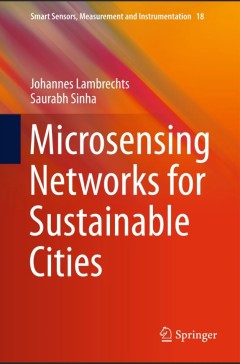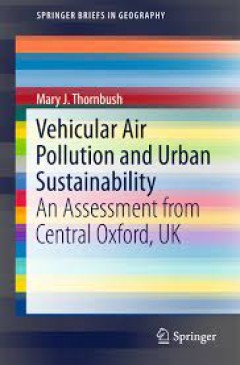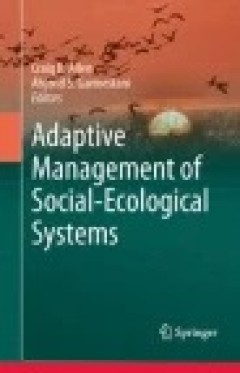Filter by

Metabolism of the anthroposphere: Analysis, evaluation, design
Over the last several thousand years of human life on Earth, agricultural settlements became urban cores, and these regional settlements became tightly connected through infrastructures transporting people, materials, and information. This global network of urban systems, including ecosystems, is the anthroposphere; the physical flows and stocks of matter and energy within it form its metabolis…
- Edition
- 2nd ed.
- ISBN/ISSN
- 9780262301329
- Collation
- 1 online resource (x, 392 pages) :illustrations, maps
- Series Title
- -
- Call Number
- -

?Alerta! :engineering on shaky ground
"The author builds on insights developed from observations of Mexico's earthquake early warning system, Sistema de Alerta S?ismica Mexicano, to show how particular social and physical conditions animate the design, maintenance, and use of environmental monitoring technologies, and how they shape where, when, and for whom these technologies manage risk"--OCLC-licensed vendor bibliographic record.
- Edition
- -
- ISBN/ISSN
- 9780262374385
- Collation
- 1 online resource.
- Series Title
- -
- Call Number
- -

Impacts of Climate Change on Rainfall Extremes and Urban Drainage Systems
Impacts of Climate Change on Rainfall Extremes and Urban Drainage Systems provides a state-of-the-art overview of existing methodologies and relevant results related to the assessment of the climate change impacts on urban rainfall extremes as well as on urban hydrology and hydraulics. This overview focuses mainly on several difficulties and limitations regarding the current methods and discuss…
- Edition
- -
- ISBN/ISSN
- 9781780401256
- Collation
- -
- Series Title
- -
- Call Number
- -

Open Source Geospatial Tools:Applications in Earth Observation
This book focuses on the use of open source software for geospatial analysis. It demonstrates the effectiveness of the command line interface for handling both vector, raster and 3D geospatial data. Appropriate open-source tools for data processing are clearly explained and discusses how they can be used to solve everyday tasks.A series of fully worked case studies are presented including vecto…
- Edition
- 1
- ISBN/ISSN
- 978-3-319-01823-2
- Collation
- XXVII, 358
- Series Title
- Earth Systems Data and Models
- Call Number
- -

Microsensing Networks for Sustainable Cities
This book explores the microsensing technologies and systems now available to monitor the quality of air and water within the urban environment and examines their role in the creation of sustainable cities against the background of the challenges posed by rapid urbanization. The opening section addresses the theoretical and conceptual background of microsensing networks. The coverage includes d…
- Edition
- 1
- ISBN/ISSN
- 978-3-319-28357-9
- Collation
- XIV, 339
- Series Title
- Smart Sensors, Measurement and Instrumentation
- Call Number
- -

Fault Detection and Fault-Tolerant Control for Nonlinear Systems
Linlin Li addresses the analysis and design issues of observer-based FD and FTC for nonlinear systems. The author analyses the existence conditions for the nonlinear observer-based FD systems to gain a deeper insight into the construction of FD systems. Aided by the T-S fuzzy technique, she recommends different design schemes, among them the L_inf/L_2 type of FD systems. The derived FD and FTC …
- Edition
- -
- ISBN/ISSN
- 978-3-658-13020-6
- Collation
- XIX, 179
- Series Title
- -
- Call Number
- -

Vehicular Air Pollution and Urban Sustainability An Assessment from Central …
This Brief examines the impact of the Oxford Transport Strategy in central Oxford as a means of assessing the effect of reduced traffic congestion in the city centre on its sustainability. Air pollution (from vehicular traffic) has been monitored at three locations in central Oxford on the High Street, St Aldates and St Ebbes (background monitoring station). There is a further monitoring site s…
- Edition
- -
- ISBN/ISSN
- 978-3-319-20657-8
- Collation
- VII, 68
- Series Title
- -
- Call Number
- -

Low-carbon City and New-type Urbanization: Proceedings of Chinese Low-carbon …
In the face of increasingly serious resource and environmental challenges, the world has already accepted low-carbon development as the main way forward for future city construction. Chinese cities have encountered many problems during their development, including land constraints, energy shortages, traffic congestion and air pollution. For this reason, the national meeting of the Central Work …
- Edition
- -
- ISBN/ISSN
- 978-3-662-45969-0
- Collation
- -
- Series Title
- -
- Call Number
- -

Adaptive Management of Social-Ecological Systems
Adaptive management is an approach to managing social-ecological systems that fosters learning about the systems being managed and remains at the forefront of environmental management nearly 40 years after its original conception. Adaptive management persists because it allows action despite uncertainty, and uncertainty is reduced when learning occurs during the management process. Often termed…
- Edition
- Ed. 1
- ISBN/ISSN
- 978-94-017-9682-8
- Collation
- XIII, 264
- Series Title
- -
- Call Number
- 574.5 ADA a

A Study of the Fukushima Daiichi Nuclear Accident Process: What caused the co…
Written by an expert in the field, this book is perfect for those who would like to know what happened at the Fukushima Daiichi Nuclear Power Plant. Part 1 of the book studies how core melts occurred in Fukushima Daiichi units 1, 2, and 3, respectively, based on evidence from the Three-Mile Island core melt accident and fuel behavior experiments performed in the 1970s under the cooperation betw…
- Edition
- Ed. 1
- ISBN/ISSN
- 978-4-431-55543-8
- Collation
- XVI, 231
- Series Title
- -
- Call Number
- 621.38 ISH s
 Computer Science, Information & General Works
Computer Science, Information & General Works  Philosophy & Psychology
Philosophy & Psychology  Religion
Religion  Social Sciences
Social Sciences  Language
Language  Pure Science
Pure Science  Applied Sciences
Applied Sciences  Art & Recreation
Art & Recreation  Literature
Literature  History & Geography
History & Geography